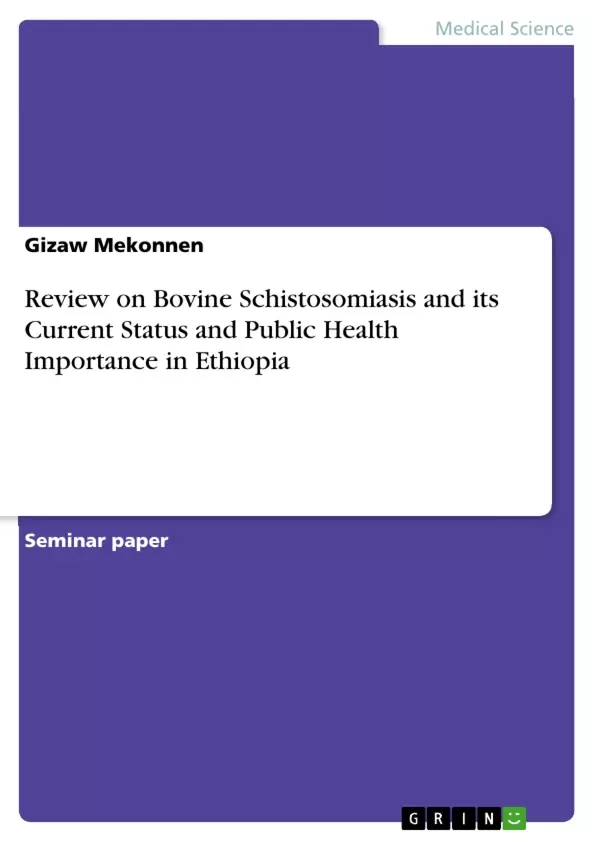Schistosomiasis is a parasitic disease transmitted by snail intermediate hosts. It is one of the most wide spread zoonotic disease which is endemic in many developing countries of the tropics and sub tropics causing considerable loss in humans and animals. The disease affects rural communities particularly those who depend upon irrigation to support their agriculture. Currently it affects between 200 and 300 million people in around 74 countries. The great majority (80-85%) of schistosomiasis is found in sub-Saharan Africa. Schistosomiasis is caused by trematode worms of the genus Schistsoma that live in the alimentary tract, bladder, as well as hepatic and nasal veins of humans and animals.
Effective transmission of schistosomiasis occurs when the schistosome parasites, the aquatic snail hosts and the human or animal definitive hosts meet in space and time in surface water. The pathological changes with the disease are attributed by the adult parasite, cercaria and the eggs of the parasite. Health education, chemotherapy, environmental and biological control as well as provision of clean water have an innumerable role in the control activity of the disease. The use of traditional medicines in the treatment of schistosomiasis are economically important and a growing concern.
There are various types of plants having anti schistosomal and molluscicidal properties with minimal side effects used by developing countries and continuous to be used in the modern world. Phytoplacca dodecandora (Endod) is the most widely studied molluscicide in Ethiopia.
Inhaltsverzeichnis (Table of Contents)
- INTRODUCTION
- BOVINE SCHISTOSOMIASIS
- Etiology
- Morphology of Schistosoma
- Taxonomy
- Epidemiology
- Risk factors for infection
- Transmission
- Pathogenesis
- Life Cycle
- Clinical findings
- Diagnosis
- Managements Of The Disease
- Treatment
- Control and prevention
- PREVALENCE OF THE DISEASE IN ETHIOPIA
- ECONOMIC AND PUBILIC HEALTH SIGNIFICANCE OF THE DISEASE
- Economic Importance
- Public Health Importance
- CONCLUSION AND RECOMMENDATIONS
Zielsetzung und Themenschwerpunkte (Objectives and Key Themes)
This review aims to provide a comprehensive overview of bovine schistosomiasis in Ethiopia, focusing on its etiology, epidemiology, pathogenesis, clinical findings, and public health significance. The review also explores current management strategies for the disease, including treatment, control, and prevention measures.
- Etiology and Taxonomy of Schistosoma species affecting cattle
- Epidemiology and transmission of bovine schistosomiasis in Ethiopia
- Pathogenesis and clinical manifestations of the disease
- Public health and economic implications of bovine schistosomiasis
- Current management strategies for the disease
Zusammenfassung der Kapitel (Chapter Summaries)
- Introduction: This chapter provides an overview of schistosomiasis, a snail-borne trematode infection that affects both animals and humans. The chapter highlights the importance of the disease in tropical and subtropical countries, particularly in areas with cattle populations.
- Bovine Schistosomiasis: This chapter delves into the details of bovine schistosomiasis, including its etiology, epidemiology, pathogenesis, and life cycle. It discusses the various species of Schistosoma that affect cattle and explores the factors that contribute to the spread and transmission of the disease.
- Prevalence of the Disease in Ethiopia: This chapter examines the prevalence of bovine schistosomiasis in different regions of Ethiopia, highlighting the geographical distribution of the disease and the factors influencing its occurrence.
- Economic and Public Health Significance of the Disease: This chapter analyzes the economic and public health implications of bovine schistosomiasis. It explores the impact of the disease on livestock production and the potential risks it poses to human health.
Schlüsselwörter (Keywords)
The key focus of this review is on bovine schistosomiasis in Ethiopia, encompassing the various Schistosoma species that affect cattle, the epidemiology of the disease, its pathogenesis, and the economic and public health implications. It explores the importance of control and prevention measures, including treatment, environmental management, and the use of traditional medicines.
- Quote paper
- Gizaw Mekonnen (Author), 2020, Review on Bovine Schistosomiasis and its Current Status and Public Health Importance in Ethiopia, Munich, GRIN Verlag, https://www.grin.com/document/520670



